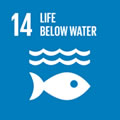Por favor, use este identificador para citar o enlazar a este item:
http://hdl.handle.net/10261/286141COMPARTIR / EXPORTAR:
 SHARE SHARE
 CORE
BASE CORE
BASE
|
|
| Visualizar otros formatos: MARC | Dublin Core | RDF | ORE | MODS | METS | DIDL | DATACITE | |

| Título: | Stranding of Mesopelagic Fishes in the Canary Islands |
Autor: | Sarmiento Lezcano, Airam N.; Couret, Maria; Lombarte, Antoni CSIC ORCID ; Olivar, M. Pilar CSIC ORCID ; Landeira, José María; Hernández León, Santiago; Tuset, Víctor M. CSIC ORCID | Palabras clave: | Myctophids Central-eastern Atlantic Stranding Otoliths Remote sensing |
Fecha de publicación: | dic-2022 | Editor: | Multidisciplinary Digital Publishing Institute | Citación: | Animals 12(24): 3465 (2022) | Resumen: | Most mesopelagic fishes perform large diel vertical migrations from the deep-sea zone to the surface. Although there is a trade-off between a higher food availability at the upper layers and an energy cost and predation risk, incursion towards the surface also implies a transport by currents, where the fish are exposed to a stranding risk on the coast. Here, we reported the first documented stranding of mesopelagic fishes along the southeast shore of Gran Canaria Island. Our study hypothesized that (1) the influence of the Canary Current, (2) the dominant incidence of the Trade Winds during summer, and (3) the presence of an upwelling filament coupled with an anticyclonic eddy south of Gran Canaria Island were the causative mechanisms of the strandings. Diaphus dumerilii (Myctophidae family) was the main species found as observed from an external morphological analysis using traditional taxonomy. The otolith contour analysis suggested the presence of other Diaphus spp. and Lobianchia dofleini. Nevertheless, the otolith morphological features described in the literature suggested that all the specimens were actually D. dumerelii. Errors in the identification were mainly due to the high intraspecific variability found in the otolith morphology. Even so, two patterns of oval and elliptic shapes were described with significant differences in its morphometry | Descripción: | Special issue Trophic Web and Predator–Prey Dynamics in Marine Environment.-- 13 pages, 6 figures.-- Data Availability Statement: The raw data supporting the conclusions of this article are publicly available through AFORO website (http://aforo.cmima.csic.es/ (accessed on 12 August 2022)) and PANGEA platform: Sarmiento-Lezcano, Airam Nauzet; Couret, María; Lombarte, Antoni; Olivar, M Pilar; Landeira, José María; Hernández-León, Santiago; Tuset, Victor M (2022): Otolith morphological measures of stranding mesopelagic fishes in the Canary Islands during June 2021. PANGAEA, https://doi.org/10.1594/PANGAEA.951480 (accessed on 12 August 2022) | Versión del editor: | https://doi.org/10.3390/ani12243465 | URI: | http://hdl.handle.net/10261/286141 | DOI: | 10.3390/ani12243465 | E-ISSN: | 2076-2615 |
| Aparece en las colecciones: | (ICM) Artículos |
Ficheros en este ítem:
| Fichero | Descripción | Tamaño | Formato | |
|---|---|---|---|---|
| Sarmiento_et_al_2022.pdf | 4,37 MB | Adobe PDF |  Visualizar/Abrir |
CORE Recommender
Page view(s)
21
checked on 27-abr-2024
Download(s)
28
checked on 27-abr-2024
Google ScholarTM
Check
Altmetric
Altmetric
Este item está licenciado bajo una Licencia Creative Commons



